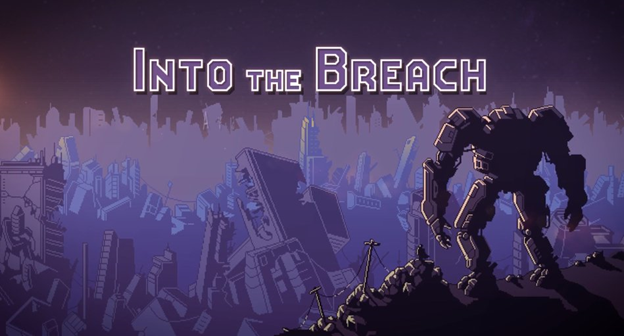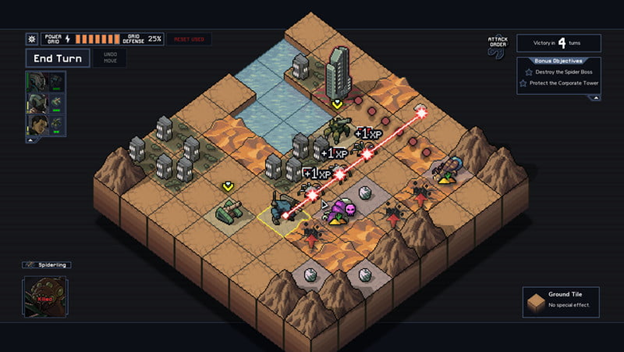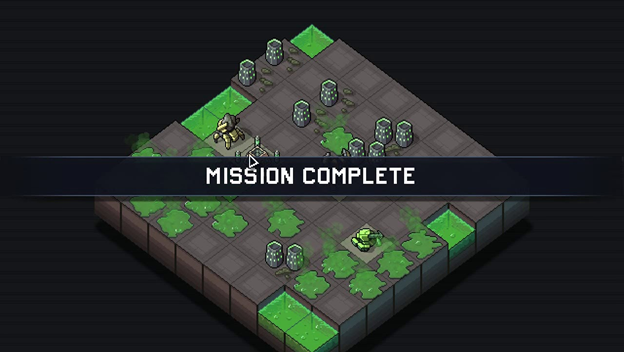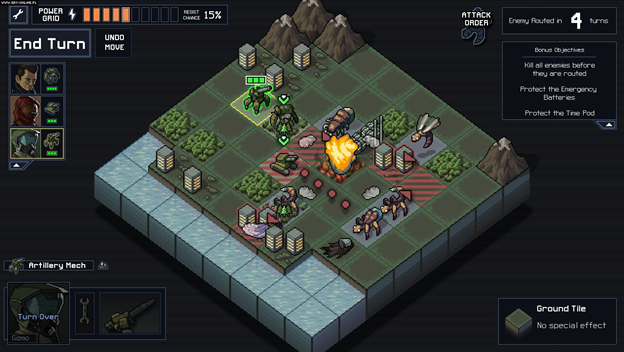INTO THE BREACH Review

Indie developer Subset Games is a case study in what it means to be “too successful.” The studio is the furthest thing from a household name, but practically anyone with a Steam account is aware of their debut title, FTL: FASTER THAN LIGHT. The 2012 starship simulator set the foundations for the modern roguelike and raised the bar for what could be achieved by independent developers. Various ports, expansions, and guest contributions from gaming legends like Chris Avellone have resulted in a legacy that dwarfs the tiny, two-man team that shook the industry.
It’s a testament to FTL’s success that such a small outfit could not only live off of its revenue for six years without a follow-up, but could completely bypass the Kickstarter route and self-fund their next game. INTO THE BREACH may be Subset’s response to the post-XCOM market by way of PACIFIC RIM, but it still very much follows in the tradition of FTL. The game places you in command of a trio of time-travelling mech pilots on an Earth ravaged by insectoid invaders called the Vek. In a series of randomly generated missions, you must protect the few remaining cities from the Vek. Should the Vek destroy too many buildings, depleting the power grid and dooming the future of humanity, one of your time-travellers is sent back to the past to repeat the process from scratch.

Rinko Kikuchi and John Boyega DLC to be announced
As one might glean from the strong Advance Wars vibe channeled by the simplistic graphics, INTO THE BREACH is a turn-based strategy game that places special significance on environmental features and terrain types. Most weapons not only damage the Vek, but have the ability to displace them from the tile they currently occupy (getting punched by a skyscraper-sized robot is bound to send anyone flying, after all). This opens up a world of tactical considerations, as the Vek must telegraph their attacks for a full turn before they execute them. You might not be able to kill the monster targeting the factory you’ve been tasked to defend, for example, but you can at least knock it off course so that it’s lunge goes wide.
Conversely, you may wish to save an ally beset by a oncoming Vek, but attacking the creature will send it crashing into a densely populated apartment building. The player is constantly forced to bend over backwards in order to find the best, if any, way out of the dilemmas such as these. This reliance on parallel thinking is both INTO THE BREACH’s most challenging and absorbing factor. It can seem impossible to stop ten separate Vek from levelling a city with only three mechs, but there’s also something immensely satisfying in using a few well-placed shockwaves to trick that horde into killing each other instead.

“You’ve reduced our city to a steaming puddle of acid! How can we repay you?”
If you couldn’t tell already, INTO THE BREACH can be a daunting experience, but its metagame is much less intimidating than its predecessor. As mentioned earlier, you may select one of your surviving pilots to go back in time should you lose (or win) the game. Beyond a flashy way of presenting new playthroughs, this ensures that you may retain some degree of persistence between games, as that pilot will retain any previously earned skills. Additionally, you are permitted to re-do one turn per mission, so whether you made a catastrophic miscalculation or noticed a way you could down another Vek, there is some room for leniency. Despite representing a genre notorious for punishing player/character attachment, INTO THE BREACH is surprisingly accommodating of those who would like to actually invest in their avatar.
All of this being said, there is a catch. INTO THE BREACH’s concessions towards player comfort do compromise some of the potential stressors that encourage riskier (and more rewarding) gameplay. Because recycling your favorite pilot is as easy as hitting the “abandon timeline” button in the pause menu, and because most playthroughs rarely last longer than four hours, there is little incentive to ride out a losing battle. FTL was defined by journeys where you just barely managed to scrape by, scrounging resources and braving dangerous routes in a desperate bid for survival. Here, if a run doesn’t look like it’s going just the way you want it, all you need to do is roll the dice on a new game until the AI cooks up a scenario that plays directly in your favor. With over 20 hours logged in, I have not yet completed a campaign where I suffered any casualties; whenever that happened, it was just a matter of winding back the clock.

Kind of like if WAITING FOR GODOT had more giant bugs and tanks. Kind of
I mentioned something at the beginning of this article about setting bars. Avoiding comparisons to FTL is a futile task. FTL is more than the elephant in the room; it is the room. Indie games would be in a very different state without it, and the roguelike might just have stayed in its crypt. Does INTO THE BREACH hit the heights of FTL? No. Has anyone won the gold more than Michael Phelps? Also no, but that doesn’t mean you can’t still tear up the pool. Maybe Subset will forever be known as “the guys who made FTL.” Even if that ends up being the case, the studio is going to leave behind one Hell of a legacy. INTO THE BREACH is an undeniably fun and incredibly addictive experience. It is the year of our Lord 2018 and I have already put a day of my life into something that could feasibly have been made for the Game Boy Advance, and I can easily see myself turning that sum into a week. The game is $15, runs on a calculator, and comes bundled with a free copy of FTL. Don’t think; just get it.
Verdict: Recommend
Reviewed on PC



